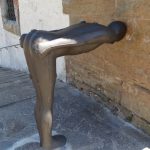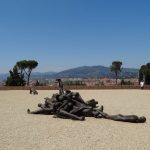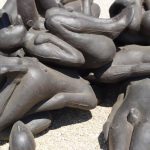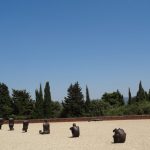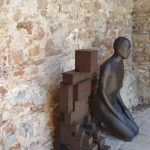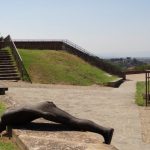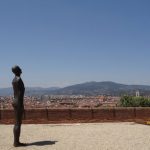Receiving an invitation to exhibit in Florence, bestows artistic greatness and historic legacy upon the recipient; an honour previously extended to an Englishman when Henry Moore’s monumental works, and those of other artists, were placed at Forte Belvedere in 1972.
For the summer Antony Gormley has temporarily been given sole tenancy for a battalion of one hundred Human sculptures. Crafted from his own image these iron bodies are intended as a generic representation of society.
Sited high on a hilltop to the south of the Renaissance city, Forte Belvedere was built at the end of the sixteenth century, to the Medicis’ calculated exactitude as a bastion of their domination and repression; previous to their own expulsion.
Fear, faith and fidelity permeated the Forte’s star-shaped perimeter walls. Those within looking down upon a menaced community nestled in a valley of gently undulating terrain. Over the centuries humanism has now prevailed to replace creeds and deities with rational thought and scientific evidence.
As a commanding observation platform it now sets a unique cultural stage. Renovated and with renewed purpose the location re-opened as an art attraction with Zhang Huan’s exhibition in 2013, followed by Guiseppe Penone’s exhibition in 2014.
The installation of Gormley’s iron figures, curated by Segio Risaliti and Arabella Natalini, utilises the time-worn weather-beaten architecture of painted plaster, brick and stone to situate the fatigued metal of each form in apposition.
Yet it is the whole of this Tuscan vale – containing iconic Florentine buildings, rolling hills and drought resistant trees to punctuate an azure blue horizon – that generously defines the entirety of the exhibition; set to a soundtrack of pealing church bells, rasping scooters and selfie-posed chatter.
The life-sized scale of Gormley’s sculptures provide an identifiable context to an otherwise hostile environment fused by its vast spacial voids. Recycled from the intended location of a disused Viennese tram station, Gormley’s naturalistic Critical Mass II (1995) sculptures redefine contemporary citizenship as intense and interactive. While his Lego-brick pixelated formation of Blockwork bodies jolt a recollection of constructed and deconstructed ‘body-forms’ as genetic data.
Set singularly the dignity of each sculpture is evident. When crowded, identity is lost and the figures become commoditised, chaotic, and alarmingly disposable. The viewer is physically charged by this searing contrast of community.
Solo figures dispersed within and against the property convey leisure in witty yoga-like stances where the unfurnished interior rooms offer seclusion and elemental shelter, affording the luxury of unguarded moments.
The geometric precision of the sculptures’ outdoor placement heightens their psychological exaggeration. The apparent casualty of bodies fallen from steps, ramparts or even the sky is disconcerting. Constrained by un-scalable walls, roofless tunnels and prison-like vaults, emotional turmoil and tensions are suppressed.
Then the sweeping expanse of the gravelled palazzina reinvigorates an awareness of social scrutiny. The foetus unfurls in twelve basic postures, including crawling, kneeling, sitting and finally standing with confident head held high towards the sky. The backs of these sculptures turn against the heaped collision of humanity lying only meters away.
The aesthetic vogue for figurative sculpture which languished during the latter part of the last century triumphantly re-engages our attention to convey a compelling message of worth.
The success of Gormley’s landscape sculptures lies in the constant repetition of meeting ourselves in the familiarity of human form; Human personifies an urban aspiration to the urbane.
